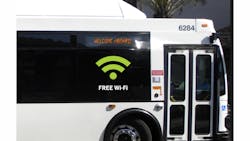After Visalia Transit in Visalia, Calif. installed an automatic vehicle location (AVL) system on its buses in 2013, it had another tool to attract new riders and give current riders a chance to give themselves a smoother commute while also giving the agency a tool to improve service.
Transit Manager Monty Cox said the cellular-based AVL system was put into place on buses, but suddenly, the local phone company decided to shut off its 2G service in the region as it continues to build 3G and 4G service. With a flick of a switch, Visalia Transit saw its AVL efforts erased.
“So that happened overnight and all of a sudden, half of our fleet AVL systems didn’t work,” Cox said. “It was a safety issue and it left us scrambling to come up with a solution. We contacted the phone company to turn it back on, but while we were scrambling for options, we realized the only option we had to do was change our modems out.”
The snafu opened a door for Visalia to offer Wi-Fi service to riders with the new modems, so another tool was brought into the system to help riders. In order to educate riders about the new system upgrades and to generate buzz about the bus, Visalia opted to reach out to technology savvy riders using a low-tech form of communication — a bus wrap.
The one bus was known as #SocialBus was launched in August 2013 and it moved riders to engage Visalia on social media.
“It was a big hit with people. They began using it immediately,” Cox said. “The first month it was out there, we were blown away about the response and realized ‘wow, maybe we found something really worthwhile.’ Our original intent was to invest in it for about a year, but then we decided it was something worth investing in for the rest of the fleet.”
Engaging riders on new technology and amenities can take many different forms from traditional television and radio commercials to bus wraps and social media. Transit agencies across North America are trying different approaches to marketing and teaching these new technologies to riders and finding varying degrees of success.
Partners in Education
Greenlink Transit in Greenville, S.C., upgraded its services with the addition of Wi-Fi and Routematch AVL and app for smart phones in order to benefit current riders and gain new ones.
Greenlink is part of the city of Greenville, so Marketing and Programs Specialist Kathy Vass said the agency leverages all the city’s social media sites to spread the word. It also works partnerships with area organizations to trade advertisements in order to find economical ways to advertise, such as trading advertisement space with the Greenville Road Warriors hockey team, so ads for the agency appear at the arena and on their website. Another partnership trades advertisement with The Children’s Museum of Upstate, so messages about new technology appear in areas people normally wouldn’t expect them.
Vass said Greenlink also partners with Entercom Radio in Greenville, in order to get messages out to a wider audience.
“The radio partnership really gives us a massive audience to push our services, not just to those who are already using our services,” Vass said.
Like most transit agencies, Vass said Greenlink is focused on targeting the technology to Millennials who are attracted to transit instead of car ownership, but the agency is also focusing on ways to spread the technology information to the Hispanic community and it’s currently working with a consultant to finds ways to get this information out.
“We’re working on SMS texting and in the process of getting accurate GPS coordinates at bus stops and shelters,” Vass said. “The texting feature, we think will be really big in the Hispanic population. We’re trying to do a lot of different things to reach out to them given the growth of the Hispanic population in the Greenville community, so a lot of people are trying to reach that community. Our consultants feel this is a low hanging fruit for us. “
Vass said another option to educate the community about technology upgrades has been local transit supporters who embrace the system and are very vocal on spreading the message across Greenville and other passengers.
“It’s a challenge because we don’t have the money for mass marketing, so a lot of it is word-of-mouth, which can be a much slower process,” she said. “If we had a million dollar budget, we’d go out and tell the world.
“But the good thing for us is as we launch something and there are glitches and it takes time to work out the glitches, but these passengers kind of do the work on our behalf to let us know when things are not quite working right.
“But yeah, it’s still a challenge, so we do the best we can with guerilla marketing, if you will.”
The Power of Social Media
Barry Barker, general manager of the Transit Authority of River City (TARC) in Louisville, Ky., said that agency has always put a high value on getting the word out to customers about what’s happening on the system, so information is delivered using various forms of social media and text messaging in order to target specific messages at riders.
“What we’re finding is folks really like it,” he said. “They like it from the point of view that they don’t have to wait in queue for someone at a customer service center to respond to a particular question when it’s something they simply want to know.”
TARC put Wi-Fi on express buses travelling from Indiana into Louisville, which will also include charging stations for riders to charge mobile devices.
Barker said technology has enhanced the TARC rider experience by making it easier to ride and navigate around town. They tout successes and how well it can work and how to use it, even for transit agency leaders going through the learning curve.
“One story is when we first put a trip planner up what I went and did is I put in my house and work and the computer gave me another alternative I had never thought about that required me to just walk another quarter mile,” Barker said. “It opened up this whole set of other options to get downtown and I can compare it to regular travel time and walking segments and show me a comparable route.
Besides educating people on how to use technology, Barker said social media allows TARC to target its audience to market the new equipment.
“The use of all this stuff to access a whole bunch of people you don’t think to access before,” he said. “People ask about Millennials Generation X and that, and I think we’re able to attract younger bus riders with a range of options like real-time information about where the bus is and how they can get on Wi-Fi and so on.”
Barker said social media has been a real boom in helping get in touch with the community and educating riders on new technology.
“Before, we were just plodding along. It was email and phone messages and letters and sort of the classic stuff, but now we’re able to reach out and touch more folks,” he said. “Now we can send out an automatic text messages to over 700 people who are signed up, on Facebook we have over 2,700 followers and on Twitter we’ve got 2,600.
“Once you start into this, it becomes organic and grows itself frankly.”
“I think that it’s absolutely worth using anyway we can to get the word out on what’s happening with a route here running from A to B or on any of the stuff happening on TARC,” Barry continued. “That stuff makes it easier to understand how to use the system is worth doing. We’ve got a tremendous investment in rolling stock. We’ve got a tremendous investment in operating rolling stock. All this social media enables us to increase ridership by enhancing the utilization of all those assets.
“It’s really about let more people know how to get from A to B.”
New Ways of Doing Business
New technology is not only making it easier for transit agencies to educate the community on new technology, but it’s also making it easier for riders to get the information they seek.
“People don’t have to go to a traditional meeting or phone something in,” Kay Stewart, marketing director for TARC said. “We get quite a few comments on Facebook or Twitter and we can use those social media sites to specifically spread that word then get comments back.
“That’s changing the whole dynamic to getting feedback when proposing changes in the system.”
Social media also spans beyond tweets and page posts, as it also provides an affordable marketing platform for more traditional outreach.
“There’s still a lot to figure out, but what has been good is Facebook advertising,” said Jon Reiter, communications manager for TARC. “A Facebook ad is great for public agencies like outs not swimming in money, but lets us really targeting riders by age group or to hear more about the routes they ride by. Facebook has been very, very helpful and it’s something we’re still trying to do more of.”
But even with the new ways of reaching and educating the public, there’s still challenges with some problems agencies are still dealing with in other areas.
“Increasingly we have more data than we know what to do with,” Barker said. “How we collect data and analyses it and protect peoples’ privacy, that’s going to be increasingly difficult.”
Cox said a full bus wrap can be an expensive investment for transit agencies to undertake, but it’s important to find new ways to engage the community and draw attention to the system. But when making an investment in educating and engaging the community, it’s important to keep up on those efforts on a daily basis to make it pay off in the end.
“That’s key for any business,” Cox said. Social networking builds the the effectiveness of engaging the public and it’s a powerful tool to keep the conversation going back and forth. We put questions out there on a weekly basis that aren’t always transit related or how people are using the bus to get to an event and people will respond back and forth. It has been interesting having different conversations and finding out how we’re targeting our audience with the tools we have.”



